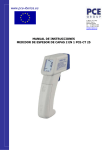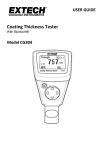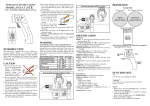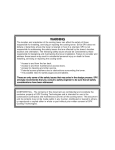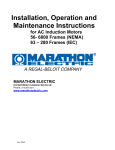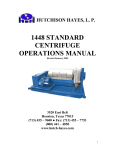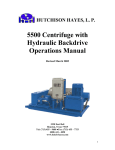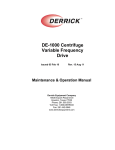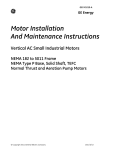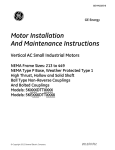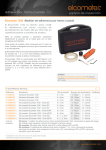Download HVT Inc. Service Manual - Hurley Ventilation Technologies
Transcript
HVT Inc. Service Manual INSTALLATION, MAINTENANCE, WARRANTY, SAFETY AND STORAGE INSTRUCTIONS WARNING – Failure to comply with the instructions could result in serious bodily harm or property damage and will void the warranty. [email protected] www.thehurleygroup.com Phone: 705-682-0862 Fax: 705-682-2572 Sudbury, Ontario, Canada Table of Contents Pre-Installation • A.) Introduction • B.) Safety precautions • C.) Shipping and Receiving • D.) Handling • E.) Storage Fan Application • A.) Installation • B.) Blade angle Settings • C.) Balance • D.) Recommended Torque - Fan blade nuts and motor mounting hardware • E.) Motors and Controls • F.) Sound Considerations • G.) Vibration Detectors • H.) Paint Operation • A.) Bearing vibration Limits • B.) Bearing Temperature limits • C.) Start-up check list • D.) Trouble-Shooting • E.) Maintenance Terms, Conditions and Warranty [email protected] A. INTRODUCTORY REMARKS PRE-INSTALLATION This manual is published to assist the customer in the storage, installation, operation, and maintenance of Hurley Ventilation Technologies Inc. axial fans. HVT Inc. warrants against defects in workmanship and material, refer to TERMS AND CONDITIONS section. In general, the HVT Inc. fan is a high performance, variable pitch vane axial fan. It is a quality product built to operate in harsh mining environments and with proper care and maintenance should give many years of satisfactory, trouble free operation. B. SAFETY PRECAUTIONS WARNING – Contact with rotating fan blades can cause severe injury or death. Never insert items into the fan to determine movement or direction of rotation. Install fan guards or screens on arrangements with exposed fans. Always use lockout and tag out procedures before performing fan adjustments, maintenance, service or inspection. It is the responsibility of the purchaser to insure that qualified personnel experienced in installing this type of equipment handle the installation. The personnel should be experienced, trained and aware of the hazards associated with electrical rotating equipment, failure to comply with these practices may result in serious bodily injury or death. THE FOLLOWING SAFETY PRECAUTIONS MUST ALWAYS BE OBSERVED: I. II. Maximum operating temperature and speed for fan equipment must not be exceeded. Bearing temperature must not be exceeded. Refer to bearing temperature limits located in "OPERATION." III. Protect properly against electrical hazards related to motor operation. Refer to specific information supplied on motor installation. IV. Protective guards for shafts, couplings, heat flingers and belts must be provided and in place during operation. V. VI. VII. Inlet and outlet screens help prevent entrance of clothing and other foreign objects into rotating parts. Access doors to fan or duct system must never be opened during fan operation. Those located on the discharge side of the fan may open violently if opened while fan is operating. To provide against possible electrical start-up of fan during maintenance, be sure to electrically lockout equipment before working on fan. III. Beware of hot surfaces. Allow sufficient cool-down period before beginning any maintenance work. IX. Remove all loose materials from inside of housing and ductwork prior to start up. Check the quality of air inside the fan and provide a watchman outside the fan before allowing anyone to enter. X. XI. XII. Inspect the fan rotor on a regular basis. The rotor is subjected to stresses from centrifugal force and vibration. It may also be exposed to particulate erosion (wear) and/or corrosion attack. A careful visual inspection of the cleaned rotor by a knowledgeable inspector should be performed periodically to insure that no cracking or other structural damage has occurred. Do not operate the fan if it has cracks or structural damage. The vibration of the fan should be carefully monitored. Be sure that vibration instruments are operating properly and that they are calibrated frequently. For further safety practices, refer to AMCA Publication 410. C. SHIPPING AND RECEIVING Upon arrival of the equipment, check that all items on bill of lading and/or invoice have been received. Partial shipments are often made. All shipments are thoroughly inspected prior to shipment. Regardless, rough handling enroute may damage the fan components. The receiving party must thoroughly inspect all shipments for possible damage. Any damaged parts are the responsibility of the carrier and should be reported to him immediately upon arrival. HVT Inc. cannot be held responsible for adjustment of such claims if the delivery receipt is signed without specific notation of shortage or damage. Any damages noticed after delivery should be reported to the carrier at once. Request their inspection of the shipment and fill out a concealed damage inspection report. HVT Inc. must be notified in writing immediately of any lost or undelivered parts. Complaints issued more than 30 days after delivery may not be reviewed by HVT Inc. D. HANDLING UNITS SHIPPED COMPLETELY ASSEMBLED Fans arriving at the job site assembled can be picked up using slings and padding or spreaders to avoid damage. Where slings are used, they should be placed at the lifting lugs. ALWAYS MAKE SURE THAT ALL LIFTING AND HANDLING EQUIPMENT AND TECHNIQUES CONFORM TO CURRENT SAFETY STANDARDS. Avoid lifting fans or parts of fans in a way that will concentrate stresses that may bend or distort fan parts. Never pass slings or timbers through the inlets of the fan housings. THE FOLLOWING MUST ALSO BE OBSERVED DURING HANDLING: 1. Never allow chains to be in contact with the rotor during lifting. 2. Be sure that slings are not damaged in any way and are rated to lift the weight of the fan equipment. 3. Never lift rotor by blades or flanges. E. STORAGE 1. STANDARD REQUIREMENTS HVT Inc. fans are suitably prepared at the factory to protect them during shipment to the job site and for a reasonable period before installation. If not installed immediately, the fan should be protected to remain dry at all times. For shipment of assembled fans, the rotor may be blocked or strapped to avoid rotation during shipment. Be sure to remove the blocks or straps prior to operation. 2. LONG-TERM REQUIREMENTS If fans must be stored for an extended period, the storage site should be a clean, dry, wellventilated, properly drained, temperature controlled environment (10-50ºC) protected from rapid and extreme changes in humidity and free of any shock or vibration of 2 mils maximum at 60 hertz, to prevent motor bearings from brinelling. All units equipped with space heaters are to have the heaters connected if storage conditions exceed these environmental limits. For pre-assembled units, include room for inspection, lubrication, and maintenance, such as turning the fan rotor by hand to make certain all parts retain proper lubrication and shaft does not take a set. When the fan is in storage for more than three months, the rotor should be rotated manually every three months. Rotors are to be marked such that a different blade is in the vertical position after each rotation. Motor windings are to be meggered at the time of storage and also at the time of storage removal with the values recorded. Any drop in resistance value greater than 50% will necessitate electrical or mechanical drying of the motor. Further, motor bearings should be checked for moisture. If moisture is present, the bearings should be replaced. NOTE: Industry standards dictate that a motor should megger at least 1 megohm plus KV rating of motor as new. Therefore, megger reading after storage should not be less than 1 megohm. 3. BEARING PROTECTION (PERTAINING TO BOTH SHORT AND LONG TERM STORAGE) Prior to shipment, fans are factory tested. All bearings are prelubricated and should not require additional grease for start-up. If the fan is not expected to be put into use immediately, it is advisable to add lubricant so as to destroy any air gaps in the bearing reservoir, which may collect moisture. At start-up, excess lubricant will be released through the seals. This is a normal purging action, which will permit cooler operation, and the lubricant should not be replaced. NOTE: Extreme caution must be taken not to contaminate bearings when working on them. Upon removal from storage, the following procedures should take place: 1. Thorough examination to insure that no build-up of foreign material has occurred from the elements or near-by processes. 2. Examination to make certain that paint or coatings, and all other components are still in excellent operating condition. 3. Bearings re-lubricated to specifications as described in lubrication section. FAN APPLICATION Improper duct design can cause a system effect that decreases fan performance. When connecting the fan to the ductwork, care should be taken to avoid twisting or deforming of the housing as this may cause the blades to strike the fan casing and/or cause vibration and noise problems. Fans with open inlets require the use of an inlet bell or cone. Published fan performance and efficiency is based on the use of these items. Operation of the fan without these accessories will result in decreased performance and increased noise levels; furthermore a bad inlet condition could lead to premature rotor failure. There should be a distance of at least two fan diameters from the face of the inlet bell to an obstruction such as a wall. The minimum free distance from the inlet to either side or the roof should be one fan diameter. Whenever feasible a diverging cone on the fan discharge should be installed in order to minimize the velocity pressure loss and regain static pressure. Elbows immediately adjacent to the fan inlet and outlet should be avoided. When elbows are used, turning vanes should be installed to minimize turbulence to the air entering the fan. Butterfly dampers are not recommended for throttling at the fan inlet. Refer to AMCA Publication 201 "Fans and Systems" for additional information on duct design and system effects. WARNING: Axial fans should not be operated in the stall/surge region. The stall/surge region is defined as any region in which the system resistance line does not pass through the normal operating curve. Any attempt to operate this equipment in this stall region can be extremely dangerous and may result in damage to equipment as well as nearby personnel. Typical symptoms of fan operation in the stall region: • Marked decrease in volume. • Marked decrease in amperage. • Marked decrease in pressure. • Marked increase in noise level. • Marked increase in vibration levels. The depth of the stalling dip and the amount of the marked decrease or increase is directly related to the hub-tip ratio of the fan. Fans with smaller diameter hubs and longer more slender blades have a much less pronounced stalling dip and corresponding decreases or increases than does a fan with a large hub and short blades. It should be noted that operating a fan in the stalling range for prolonged periods could result in premature mechanical failure due to excessive vibrations and / or resonance and blade loading fluctuations which can cause cyclic bending of the blades, resulting in failure. Pulsations or blowback can occur if a fan is operated too near its’ shut-off pressure in the unstable region of the fan curve (stall zone). The fan will have unstable characteristics, as it hunts for a stable operating point. Note however, that steady operation within this region is possible, however, most often at a decreased flow rate but is not recommended. A. INSTALLATION NOTE: BE SURE THAT ALL EQUIPMENT IS ELECTRICALLY LOCKED OUT DURING ALL PHASES OF INSTALLATION. B. BLADE ANGLE SETTINGS On all fans, the blade angles have been pre-set at the factory for the duty required. The blade index range is numbered from 0-6 for type 2000 and 3000 blades and 0-16 for the type 1000. The number 0 is the highest angle of attack in all three-blade types and as such requires the greatest brake horsepower. As the setting moves towards the higher number setting – 6 or 16, the flow, pressure and brake horsepower are reduced. In order to determine the correct blade setting for a given blade tip angle, reference the “Blade Setting versus tip angle degree Chart”. Should it be necessary to re-adjust blades, be sure that each blade is set at the same index number. Furthermore, it is recommended to verify the blade tip angle degrees with a protractor, as the numbered settings are provided for convenience and allow for quick approximate field adjustment. Once adjustments are completed, the rotor should be turned by hand to ensure that none of the blades are striking the shell casing or bulkhead support. Motor amperage should be verified once the fan is energized to prevent motor overload, maximum amperage draw is indicated on the exterior of the fan casing on the fan and/or motor nameplate. To adjust blades, the following procedure should be used: a) Mark the aluminum spun nose cap relative to the hub and mark fasteners and extra washers (trim balance weights). b) Remove cap and store the mounting hardware. c) Loosen the blade locking nuts. d) The ideal method for establishing the correct blade angle is by using a protractor to set the blade tip angle degrees. The numbered settings are for working approximations. e) Tighten the lock nuts to the appropriate foot-pounds of torque based on Table I in the “Recommended Torques for Fan Blade nuts and motor mounting bolts” section. During the tightening process the blade position should be held in position to ensure that the selected position does not change. f) After setting all blades, a check should be performed to ensure identical blade positioning of the complete set. g) Re-install the nose cap by matching the mark placed in step a) and replace all fasteners and washers in their original positions to ensure original factory balance quality. Due to the fact that only one half hour to one hour of labor is required to perform a blade angle change on any adjustable pitch fan, it is the responsibility of the customer to adjust the blade settings. The motor-nameplate current is not to be exceeded when the ventilated system is operational. C) Balance The fan was operated/tested at full voltage/rpm and dynamically balanced to a precise degree during assembly. Our factory recommended specifications, are listed below in the table titled “HVT Standard Vibration limits”. This balance must be maintained to assure long and faithful operation. HVT Fan Standard Vibration Limits RPM SMOOTH ALARM SHUT DOWN 3600 .5mils / .09 Vel. 1.3mils/ .25 Vel. 3.0mils/ .56 Vel. 1800 1.0mils/ .09 Vel. 2.6mils/ .25 Vel. 5.0mils/ .47 Vel. 1200 1.5mils/ .09 Vel. 4.0mils/ .25 Vel. 7.0mils/ .44 Vel. 900 2.mils/ .09 Vel. 5.3mils/ .25 Vel. 8.0mils/ .38 Vel. CAUTION: Do not attempt to balance a mechanical problem or a dirty fan. D.) RECOMMENDED TORQUES FOR FAN BLADE NUTS AND MOTOR MOUNTING BOLTS. TABLE I. Fan blade nuts. Rotor SIZE Torque (ft-lbs) 14” 130 17” 130 18” 180 21” 220 26” 220 30” 450 TABLE II. Motor mounting bolts. Bolt Size Torque (ft-lbs) 1/2” 120 5/8” 160 E.) MOTORS AND CONTROLS HVT INC. STANDARD FAN APPLICATION MOTOR SPECIFICATIONS HURLEY VENTILATION TECHNOLOGIES INC. IS PLEASED TO PROVIDE TOSHIBA PREMIUM AND HIGH EFFICIENCY AC INDUCTION MOTORS AS A STANDARD IN OUR FANS. EFFICIENCY: PREMIUM ENCLOSURE: TEAO SERVICE FACTOR: 1.25 INSULATION CLASS: F BEARINGS: ANTI FRICTION HIGH TORQUE DESIGN: B VOLTAGE: 380/440/575V/3ph/50-60cy MOUNTING: HVT C-FLANGE FLANGE MOUNT COMPLETE WITH: CAST IRON FRAME CAST IRON END BRACKETS CAST IRON OVERSIZED CONDUIT BOX ON 575V MOTORS ALKALYD PAINT FINISH (GRAY) TWO (2) DRAINS IN FRAME OVERSIZED BEARINGS CSA APPROVED AND UL RECOGNIZED STAINLESS STEEL NAMEPLATE HVT AXIAL FAN DESIGN AND SPECIFICATIONS Note: Other motor manufacturers drives can be supplied upon request. 1. STARTING TIME The starting time can be calculated as follows: time = (WR²) (delta RPM) / (307.2) (avail. torque) time (seconds) delta RPM = change in speed (rev/min) avail. Torque = (motor torque capability)-(fan torque requirement) at all speeds from zero to normal operating speed (lb-ft) WR² = fan rotor rotational moment of inertia (lb-ft²) Most single speed fans will achieve full operating speed in 25 seconds or less. Longer starting times can result in motor overheating. The following are typical causes of excessively long starting time: 1. Driver torque not adequate for fan rotor WR² and the fact that it may be used with any standard motor. 2. Low voltage, causing reduction in motor torque capability. The high starting torque and high starting current may shock the driven fan equipment. 3. Partially open fan inlet damper, causing increase in fan torque requirement. 4. Low temperature (high density gas) causing increase in fan torque requirement. 5. Driver speed-torque curve not providing enough available torque when compared to fan torque requirement. NOTE: Drivers are often sized for the operating horsepower at process temperatures and are incapable of starting the fan at cold conditions unless the inlet damper is fully closed throughout the start-up. 2. MOTOR OVERCURRENT PROTECTION CONDITION. The electric current during starting is typically 5 to 7 times the motor full load current. Motor thermal overload protection is recommended to prevent burnout from misapplication or excessive number of starts. Thermal overload protection must be selected to allow high current for up to 25 seconds or more in some cases when starting high-inertia fans. Electric Code may allow dual element time delay fuses to be rated at 125% of the motor full-load current for all AC squirrel cage motors with full voltage, resistor, reactor, or auto-transformer starting under normal conditions. In cases where this rating is insufficient for the starting current of the motor, the rating of the fuses may be increased up to a maximum of 140% of the motor fullload current. 3. STARTERS AND CONTROLS Full Voltage Starting (Across-the-Line) initially connects the motor directory to the power lines. The advantages of this method are its low cost, high starting torque, low maintenance, and the fact that it may be used with any standard motor. Note that the high starting torque and high starting current may shock the driven fan equipment. Auto Transformer Starting (Reduced Voltage) limits input voltage and reduces inrush current. Normally an adjustable timer is provided for switching to full voltage after the motor has partially accelerated. Note that motor output torque is reduced by the square of the voltage reduction at the motor and, therefore, starting time is extended. Wye Start/Delta Run allows starting at reduced phase voltage, reduced load and inrush current. Starting voltage is full voltage divided by the square root of three. High transient currents are possible at the transition from wye to delta. This is a non-standard motor connection that must be specified at order time. Note the full load amperage and the motor service factor as listed on the motor nameplate. Monitor the motor current and DO NOT OPERATE THE MOTOR IN AN OVERCURRENT CONDITION. In most cases the fan must be connected to the system ductwork and/or dampers closed to provide a system resistance before operating the fan. In general, on motors above 200 HP, do not restart more than once every 30 minutes. Detailed start-up limitations are available from the motor manufacturer. 4. VARIABLE FREQUENCY AC APPLICATIONS Operation below 30% of the motor normal speed at 60 Hz should be reviewed with the drive supplier. Variable frequency drives should be properly matched to the motor. Belt drives are not recommended for variable speed applications. 6. MOTOR BEARINGS Refer to motor manual for motor bearing lubrication instructions (general guideline below). The recommended vibration alarm and shutdown limits for the motor bearings are the same as the limits for the fan bearings. Motor bearing loads must be adequate for rotor weight on Arrangement #4 and for belt pull on Arrangement #1 and #9. Service Conditions Standard Duty 8 hours/day, light to normal loading, clean condition, free from dust. Severe Duty 24 hours/day, or light to normal shock loading vibration, exposure to dirt or dusty conditions. For very severe conditions where the motor is subject to high vibration or heavy shock loading and vibration use 1/3 of the value shown in the severe duty table. Very Severe Duty 24 hour/day, high ambient, normal to high shock loading, vibration, dusty conditions, confined mounting conditions Greasing Intervals RPM Range FRAME Standard Duty Severe Duty Very Severe Duty 3600 143T – 256T 8 months 4 months 1 month 3600 284T – 365T 8 months 4 months 1 month 3600 404T – 447T 8 months 4 months 1 month RPM Range FRAME Standard Duty Severe Duty Very Severe Duty 1800 - 900 143T – 256T 30 months 12 months 4 months 1800 - 900 284T – 365T 24 months 12 months 4 months 1800 - 900 404T – 447T 18 months 8 months 3 months 7. Other notes: Drive rotation must match required fan rotation for full flow operation per fan curve. Note that fan rotation is "as viewed from the motor end" and motor rotation is "as viewed from the end bell" (opposite the shaft end). F.) SOUND CONSIDERATIONS Sound Power Level ratings shown are decibels referred to 10-¹² Watt and obtained in accordance with AMCA Standard 300. Sound Power Level for each band and dBA are calculated per AMCA Standard 301. Levels shown do not include motor or auxiliary equipment. Data is for use by a system acoustical design engineer for evaluation of the fan singularly and within a system. Because of the infinite variations in system arrangements and the many factors, which affect sound pressure levels, it is the designer's responsibility to properly apply this data based on his knowledge of the system. Some guidelines for use of this data are: for "NEAR FIELD" reported data to apply to ducted inlet and outlet installations, any opening in the duct must be a minimum of 100 ft. away from the fan. Openings within this range are assumed to emit a sound pressure equal to the fan Sound Power Level. This also applies to untreated inlet and outlet expansion joints. Note that for ducted inlet/outlet the ductwork thickness must equal the fan housing thickness to achieve the Sound Pressure Levels noted. NEAR FIELD - A hemispherical space where sound pressure waves from one radiating surface tend to interfere with waves generated by other surfaces. NEAR FIELD boundary, distance from radiating surface, is related to the wavelength of lowest frequency and overall size of source. FREE FIELD - Area beyond near field, with no obstructions, where Sound Pressure Levels decay 6 dB for each doubling of distance from near field. Effects of the room constant (for indoor installations), background noise levels, and directivity are not considered. The tolerance on Estimated Sound Power and Sound Pressure Levels is typically +/-2 dBA plus the accuracy tolerance of the measuring instrument. G.) VIBRATION DETECTORS – Main Mine or critical fan installations It is strongly recommended that bearings be equipped with seismic vibration detectors mounted on the bearing housing or on the bearing pedestal. This is an option available to customers. Accelerometer type devices mounted directly on the bearing are recommended. Such units should have adjustable alarm and shut down vibration set points and solid-state electronics that are reliable over a long period of time with a high degree of accuracy. The operation of these vibration pickups should be checked monthly and calibrated at least once every 6 months. The use of these is highly recommended as operation at high vibration levels may result in catastrophic failure with resultant damage to equipment and injured personnel. Others typically supply vibration monitors and wiring. H.) PAINT Steel equipment will normally be supplied with two coats of red oxide primer (suitable for acceptance of a wide range of customer finish coats) unless special paint is requested. No paint will be applied to stainless steel or aluminum parts. Take care in the handling of painted parts to avoid scraping that could result in rusting. Painted steel parts that are to be stored more than two months prior to being placed in service should be stored indoors at reasonable levels of temperature and humidity. Refer to storage section. OPERATION A. RECOMMENDED OPERATIONAL PARAMETERS BEARING VIBRATION LIMITS (identical to the fan vibration limits) Alert supervision when any reading increases by more than 50% in one week or if the levels exceed the alarm level as shown in the attached vibration severity chart. Shutdown for balancing and inspection may be required above this level. As a general guide, bearing temperature limits are as follows: Lubricants Condition Standard Synthetic Normal 80º C or lower 110º C Alarm 90ºC Shutdown 100º C 120ºC 130ºC Do not run bearings at excessive temperatures; it can result in premature failure. B. START-UP BEFORE STARTING FAN, COMPLETE THE FOLLOWING LIST: 1. Lock out the power source. 2. Rotate rotor to see that it does not rub and maintains proper inlet piece/rotor clearances. 3. Check fan and ducts for any foreign material or dirt build-up. 4. Secure all access doors. 5. Check lubrication of bearings, couplings, drives unit, etc. 6. Secure and check safety guards for clearance. 7. Bump start and check for proper rotation. 8. Start the equipment according to recommendations of drive unit and of starting equipment manufacturers. 9. Allow fan to reach full speed, and then shut down. Make immediate corrections if any vibrations or unusual sounds have been detected. C. TROUBLE-SHOOTING TROUBLE-SHOOTING GUIDE PROBLEM: Vibration and noise 1. Loose or broken bolts, O.D.E motor supports or setscrews. 2. Defective bearings or rubbing shaft seal. 3. Out of balance fan wheel. 4. Weld cracking. 5. Improper fan wheel clearance to inlet piece(s), rubbing. 6. Material build-up and/or wear on wheel or foreign material in housing. 7. Improper wheel rotation. 8. Operation near system critical speed. 9. Shaft bent or distorted. 10. Defective motor. 11. Resonant frequencies of structural steel. 12. Beat frequency with other fans on common base. 13. Loose hub to shaft fit. Duct Pulsation This often occurs when a fan is operated on a system with high resistance. The fan is forced to operate far below the normal or design volume. If the operating volume is lower than the value corresponding to the fan's peak static pressure, instability (surge) can occur. Possible solutions include: 1. Increase operating volume (reduce system resistance). 2. Recirculate a portion of the air back to the fan inlet. High Motor Temperature 1. 2. 3. 4. Improper ventilation of cooling air to motor, (may be blocked by dirt). Input power problems, (especially low voltage). High amperage. High ambient temperature Poor Performance 1. Damaged rotor assembly. 2. 3. 4. 5. 6. Incorrect fan rotation. Poor duct design on inlet or outlet. Air leaks in the system. System resistance is excessive compared to design requirements. Fan speed too low/high. Density may be different than design density. High Bearing Temperature 1. 2. 3. 4. 5. 6. Lack of lubrication. High ambient temperatures or direct exposure to sunlight. Improper location not enough room for free axial Defective bearings. Over lubrication. Improper lubrication or contaminated lubricant. Excessive Starting Time 1. 2. 3. 4. 5. 6. Motor improperly sized for fan wheel WR². Inlet dampers not closed during start-up. Properly selected time-delay starter/fusing required. Temperature at Inlet is excessively low (high density). Low voltage at motor terminals. Inadequate system resistance. NOTE: Do not exceed motor manufacturer's specified number of starts per hour. D. MAINTENANCE PREDICTIVE MAINTENANCE Routine vibration monitoring and trend analysis is recommended. This allows early detection of problems so that potentially hazardous operation or unscheduled shutdowns can be avoided. Contact HVT Inc. for more information on this service. TERMS AND CONDITIONS OF SALE CONTRACT AND ACCEPTANCE Seller’s acceptance of this order is expressly conditioned on Buyer’s assent to the terms contained herein. An authorized employee of Seller at its factory must accept all orders. SHIPPING SCHEDULE Seller will establish shipping schedules as closely as practicable in accordance with Buyer’s requested delivery date. However, Seller shall not be responsible for delays in performance resulting from causes beyond its control or the control of its suppliers or subcontractors; including, but not limited to any casualties, acts of Buyer, strikes or other labour difficulties, shortages of labour, supplies and transportation facilities. Seller reserves the right to ship in advance of any Buyer request dates, except those dates stipulated “Not Before”. Should shipment be held beyond scheduled date for the convenience of Buyer, the Seller reserves the right to bill immediately for the goods and to charge Buyer for reasonable expenses incident to such delay. PRICES All quotations expire sixty (60) calendar days from the date of quotation unless otherwise stipulated. Prices of products scheduled for shipment more than twelve (12) months after the date of Buyer’s order shall be subject to escalation. TERMS OF PAYMENT Subject to the approval of Seller’s Credit Department, terms of payment are net; thirty (30) days unless otherwise stipulated. TAXES Seller’s prices do not include any applicable sales, use, excise or similar taxes. If, under any law or regulation in effect, the Seller is required to pay or collect any tax upon the products arising from the sale, transportation, delivery, use or consumption of said products, whether directly or indirectly, the contract price shall be increased by the amount of any such tax. TERMINATION In the event Buyer terminates all or any portion of an order, for reasons other than Seller’s default, Buyer agrees to pay the costs already incurred by Seller to date of cancellation, including the price of any goods or services required to fill the order already committed to by Seller and a reasonable allowance for overhead and profit. WARRANTIES Seller warrants that the products covered by this contract conform to applicable drawings and specifications accepted in writing by Seller, will be free from defects in material and workmanship will be merchantable and will perform in accordance with the detailed specifications accepted in writing by Seller. These warranties extend for a period ending twenty-four (24) months from the date of shipment. Buyer’s exclusive remedy and Seller’s sole responsibility under these warranties is to repair, replace, or refund the amount paid for such part or product. These warranties exclude the cost of removal or reinstallation. For purposes of remedying any defects, Buyer agrees to provide Seller with reasonable assistance and access to the Work. Component parts and accessories not of the Seller’s manufacture are warranted only to the extent that the manufacturers thereof warrant them. THERE ARE NO OTHER WARRANTIES, EXPRESS OR IMPLIED, WHICH EXTEND BEYOND THOSE SET FORTH ABOVE. THE WARRANTY OF MERCHANTABILITY IS LIMITED TO THE TIME PERIOD SPECIFIED ABOVE. These warranties are contingent upon the product being stored, installed, maintained, and operated in accordance with good engineering practices and the instructions contained in the Seller’s Operating and Maintenance Manual. Claims for expenses of Buyer relating to labour and/or material supplied by Buyer (commonly known as “Back charges”) will not be honoured by Seller unless Buyer obtains the prior written consent of authorized personnel at Seller’s factory to supply such labour and/or material. TRANSPORTATION CHARGES AND RISK OF LOSS Unless otherwise agreed all shipments are f.o.b. factory. Risk of loss for the products sold hereunder passes to Buyer upon delivery to the carrier. LIMITATION ON LIABILITY Seller’s total responsibility for damages (whether arising in contract or tort) arising out of or relating to its performance of this contract or the products covered hereunder shall be limited to the contract price for the product. In no event shall Seller be liable for any incidental or consequential damages such as lost profits, loss of use of productive facilities or equipment, lost production, or expenses incurred in reliance on Seller’s performance, whether suffered by Buyer or any third party. Nothing in this paragraph shall in any way be construed to affect the liability Seller may have for personal injury or death of any third party. INDEMNITY Seller shall indemnify Buyer from all liability, including reasonable attorney’s fees, for personal injury or death to any third party, arising out of the sole negligence of Seller, its agents, servants or employees, while Seller is on Buyer’s premises in the performance of this contract. MODIFICATION This contract constitutes the entire agreement between Buyer and Seller relating to the products supplied hereunder. All modifications to the contract must be by written agreement. Any charges in specifications, quantities, schedules, materials or services requested by the Buyer shall be subject to an equitable adjustment in the contract price, time of performance, or both.
















